In many ways, Australian food reminds me of American food.
Like the United States, Australia is a country of immigrants. Large-scale migration in the last two hundred years has created a melting-pot cuisine that reflects the culinary sensibilities of different cultures from around the world.
I like to think of it as a continental potluck party where colonizers and immigrants brought to the indigenous table cooking techniques and traditions that have been assimilated and adapted to form what we now know today as Australian cuisine.
Being a relatively young cuisine, Australian food – like American food – doesn’t have as strong an identity as other global cuisines. But like the US, that hardly means you can’t find amazing food in this country. We visited Sydney many years ago and found it to be an incredibly exciting city for food.
There’s no shortage of contemporary dining experiences in Australia but if you have a taste for traditional food like we do, then here are fifteen Australian dishes that you need to try on your next trip Down Under.
AUSTRALIAN FOOD QUICK LINKS
If you’re visiting Australia and want to learn more about Australian cuisine, then you may be interested in joining a food tour.
TOURS & OTHER SERVICES
- Food Tours: Food Tours in Australia
- eSIM: Australia eSIM
Save This on Pinterest!
No time to read this article on traditional Australian food? Click on the save button and pin it for later!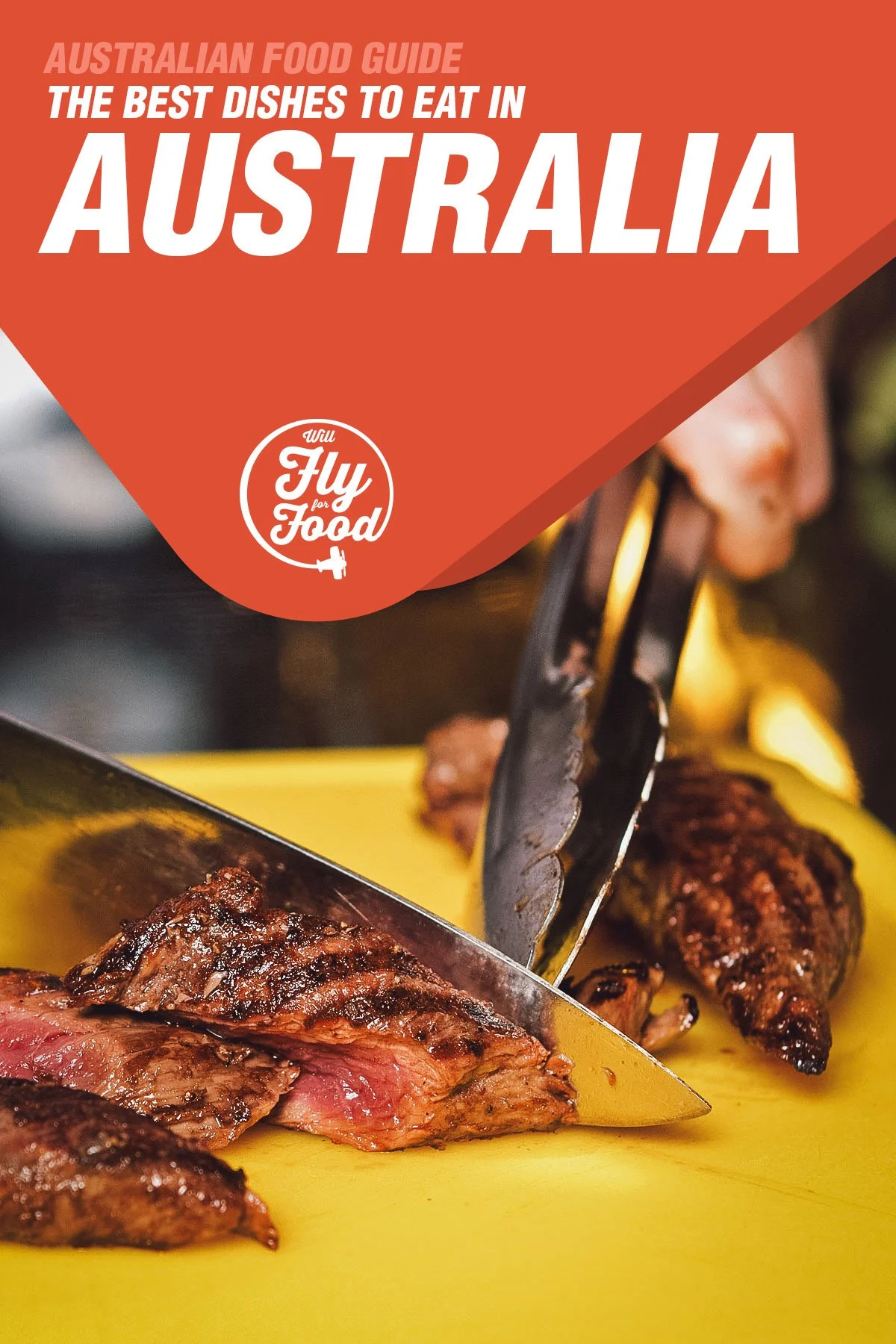
Photo by seeshooteatrepeat
WHAT IS TRADITIONAL AUSTRALIAN CUISINE?
Before the arrival of European colonizers, Australian food was essentially bush tucker or bush food. This referred to any native food that was consumed by indigenous Australians like kangaroo, emu, grubs, native yams, and fruits.
After Australia became a collection of British colonies in the late 18th century, agricultural products like cattle, sheep, and wheat became staples in the Australian diet. The Australian gold rushes in the mid-19th century introduced more immigrants to Australia, most notably Chinese, which led to the further diversification of Australian cuisine.
After World War II, Australia launched a large-scale immigration program that brought over a million displaced Europeans into the country. Only immigrants of European descent were accepted at first but a gradual easing in cultural selectivity led to a more multicultural influx of immigrants. This led to a significant diversification in the local cuisine, thanks mostly to immigrants from East Asia, South Asia, and the Mediterranean.
Today, meat and poultry constitute a large part of the contemporary Australian diet. Fish and seafood are also common though they aren’t as popular as chicken, beef, or lamb. A variety of tropical fruits, stone fruits, and temperate fruits are locally cultivated while dairy products have been produced in Australia since the time of the first British settlement.
In my opinion, bush tucker is one of the most interesting aspects of Australian cuisine. Native fruits and game meats like kangaroo, emu, and crocodile are available though they aren’t as widely consumed.
MUST-TRY AUSTRALIAN DISHES
1. Smashed Avo
Walk into any trendy brunch spot from Bali to Bogota and you’re sure to find at least one smashed avo dish on the menu.
Smashed avo is exactly what its name suggests – avocado roughly smashed on a slice of bread. Iterations of this iconic Australian breakfast dish are as plentiful as the cafes that serve them but the classic recipe is said to be made with just five ingredients – fresh avocado, good bread, lemon, mint, and feta cheese.
The exact origin of smashed avo is unclear but its first recorded sighting may have been on the menu of Australian Chef Bill Granger’s cafe – bills.
Visit Sydney and you’ll have four bills branches to choose from to try this simple but delicious dish that Gwyneth Paltrow once famously described as “the holy trinity of Vegenaise, avocado, and salt that makes this like a favorite pair of jeans — so reliable and easy and always just what you want.”
The perfect Sunday brunch dish indeed!
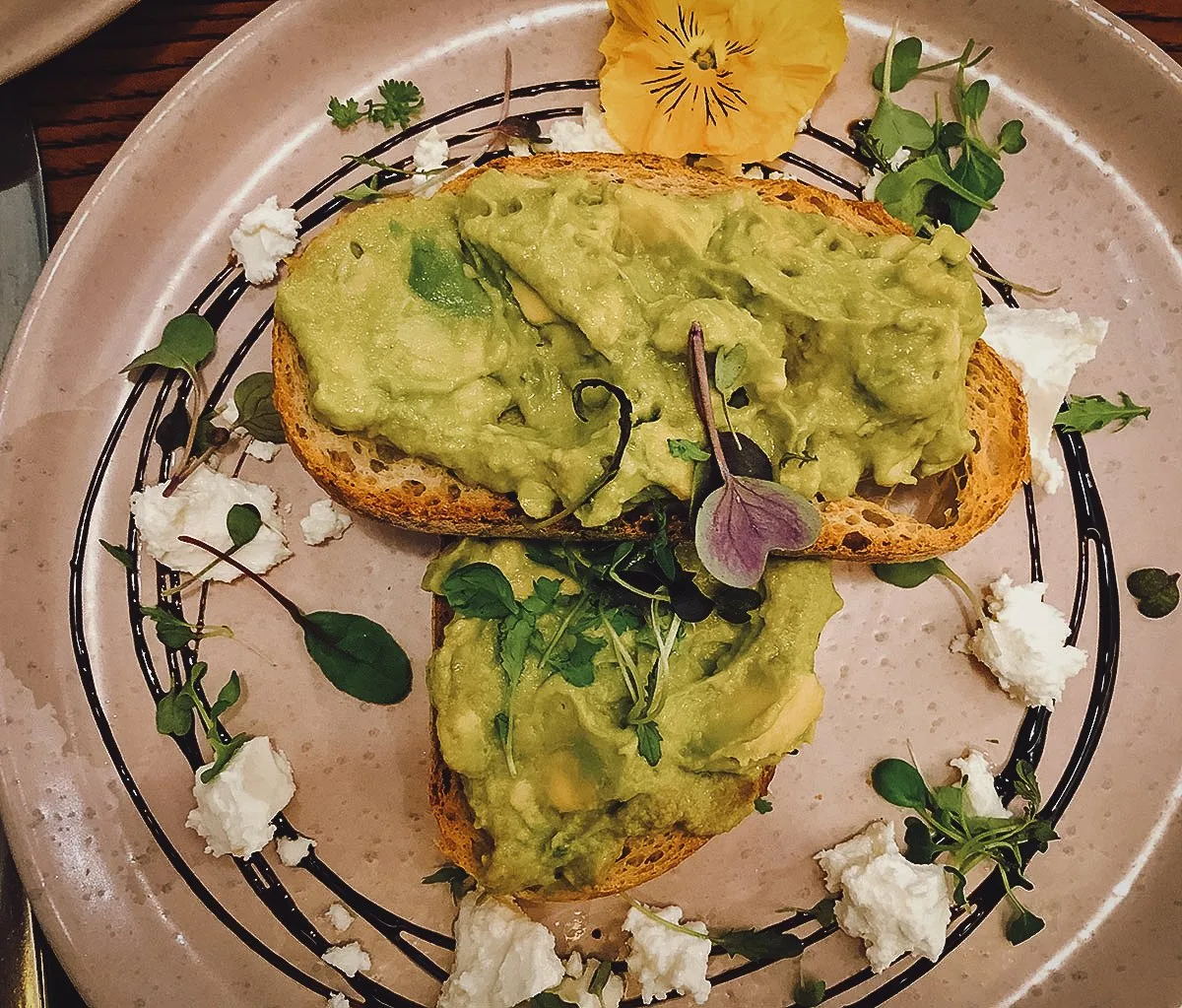
Photo by onlyjayne
2. Vegemite
Aside from kangaroo meat, this was the one dish that I was most excited curious to try in Australia.
Similar to New Zealand Marmite, Vegemite refers to a brand of Australian food spread made from leftover brewers’ yeast extract blended with various vegetable and spice additives. Thick and dark brown in color, it’s commonly consumed as a spread on toast, sandwiches, or crackers.
Unless you’re Australian and grew up eating Vegemite, then you may find its taste to be off-putting at first, even a shock. It looks similar to chocolate spread but it tastes nothing like it. It’s salty and bitter and designed to be used in moderation, preferably with butter and other ingredients like cheese or avocado to help offset its flavor.
Unsurprisingly, Vegemite wasn’t my favorite Australian dish but I can certainly understand its appeal. It’s an acquired taste much like Filipino bagoong, caviar, or beer. Once you get used to its flavor, you start liking it, looking for it, and then maybe even loving it.
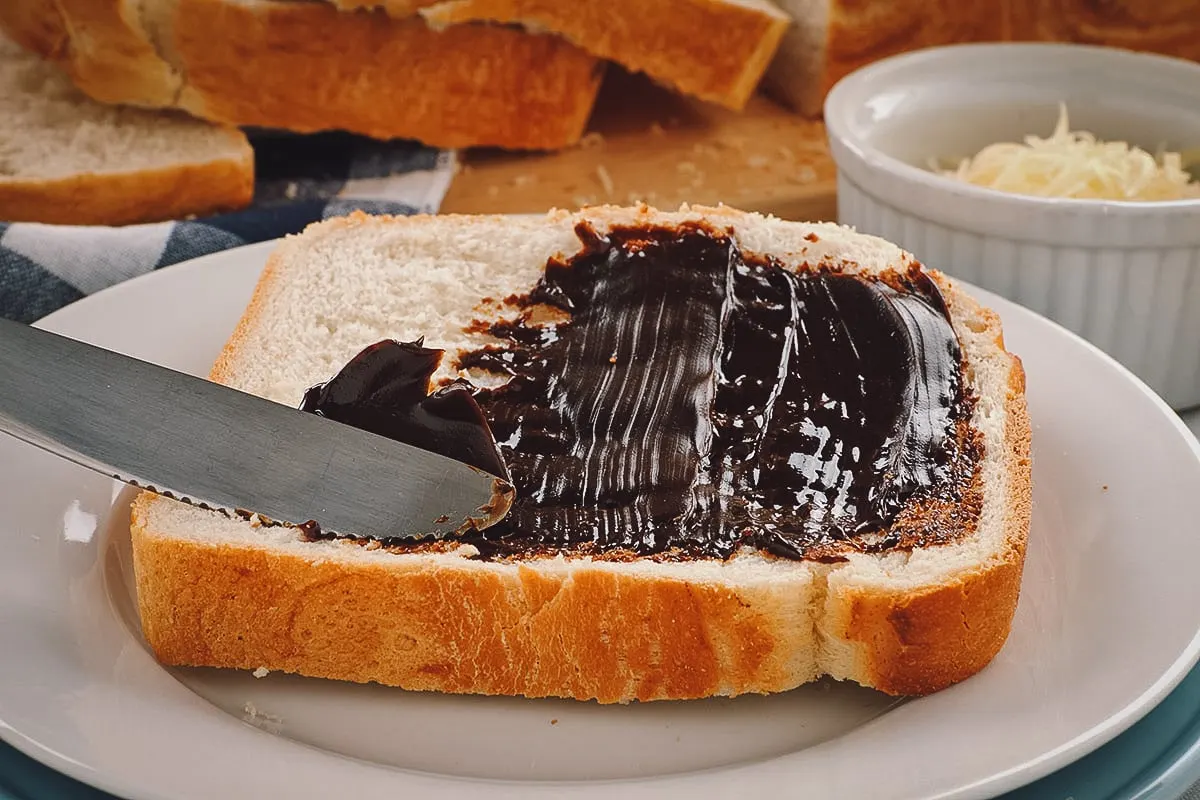
Photo by jabiru
3. Fairy Bread
Easier on the eyes and on the palate, fairy bread is perhaps the polar opposite of Vegemite on toast. Made with just three ingredients, it consists of buttered sliced white bread topped with tiny confectionery balls called “hundreds and thousands” (nonpareils) in Australia.
Fairy bread is a popular kiddie snack that’s commonly served at children’s parties in Australia and New Zealand.
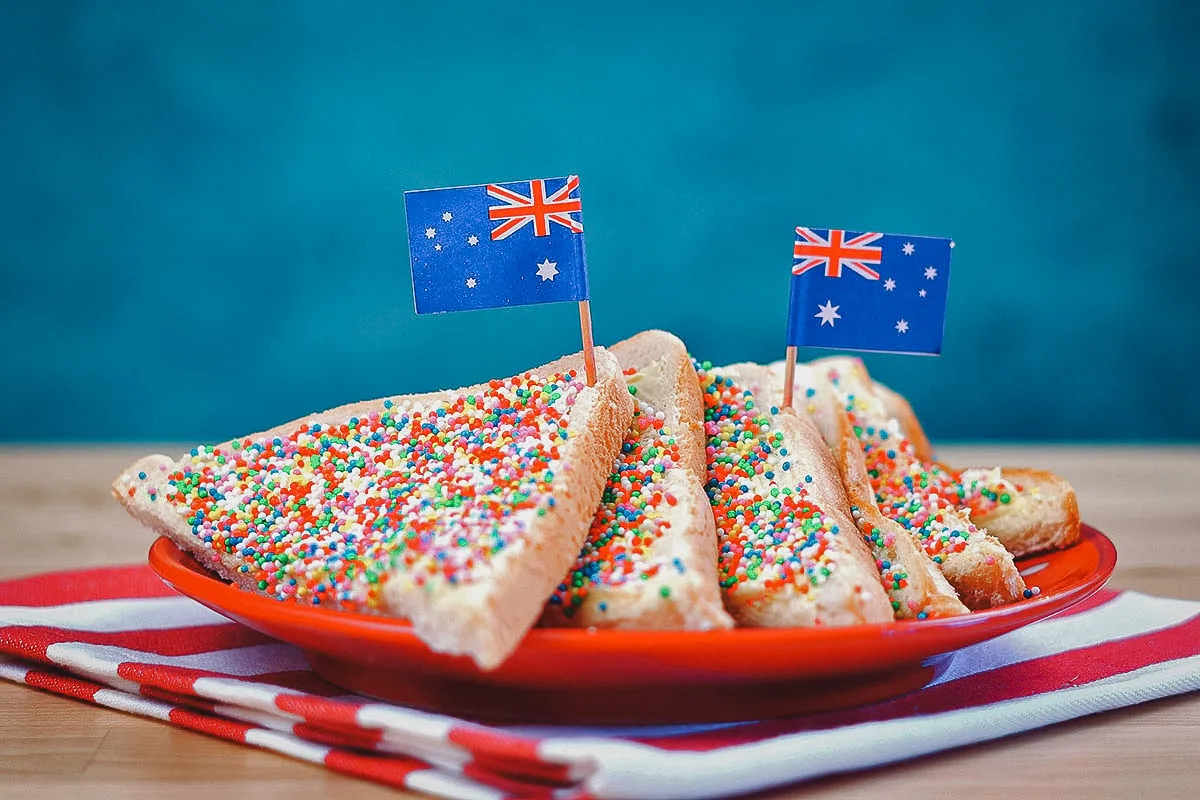
Photo by Milleflore Images
4. Chiko Roll
The Chiko Roll refers to a popular Australian food inspired by the Chinese spring roll. It was invented by Frank Monroe, an Australian caterer who debuted the product in 1951 and sold it at football matches and other outdoor events in East Melbourne, Victoria.
Chiko Rolls consist of deep-fried egg and flour pastry tubes filled primarily with cabbage and barley mixed with carrot, green beans, celery, onion, wheat cereal, beef, and beef tallow. Monroe envisioned it as a bigger and sturdier version of the Chinese spring roll that spectators could easily eat with one hand while holding a beer in the other.
At first, Monroe wanted to call it the “Chicken Roll” despite his product not containing any chicken. He would later change it to “Chiko Roll” and the rest is history.
At the height of its popularity in the 1960s and 70s, an estimated 40 million Chiko Rolls were sold in Australia every year. Like Vegemite, it’s become an Australian cultural icon that continues to be sold at sporting events and supermarkets throughout Australia.
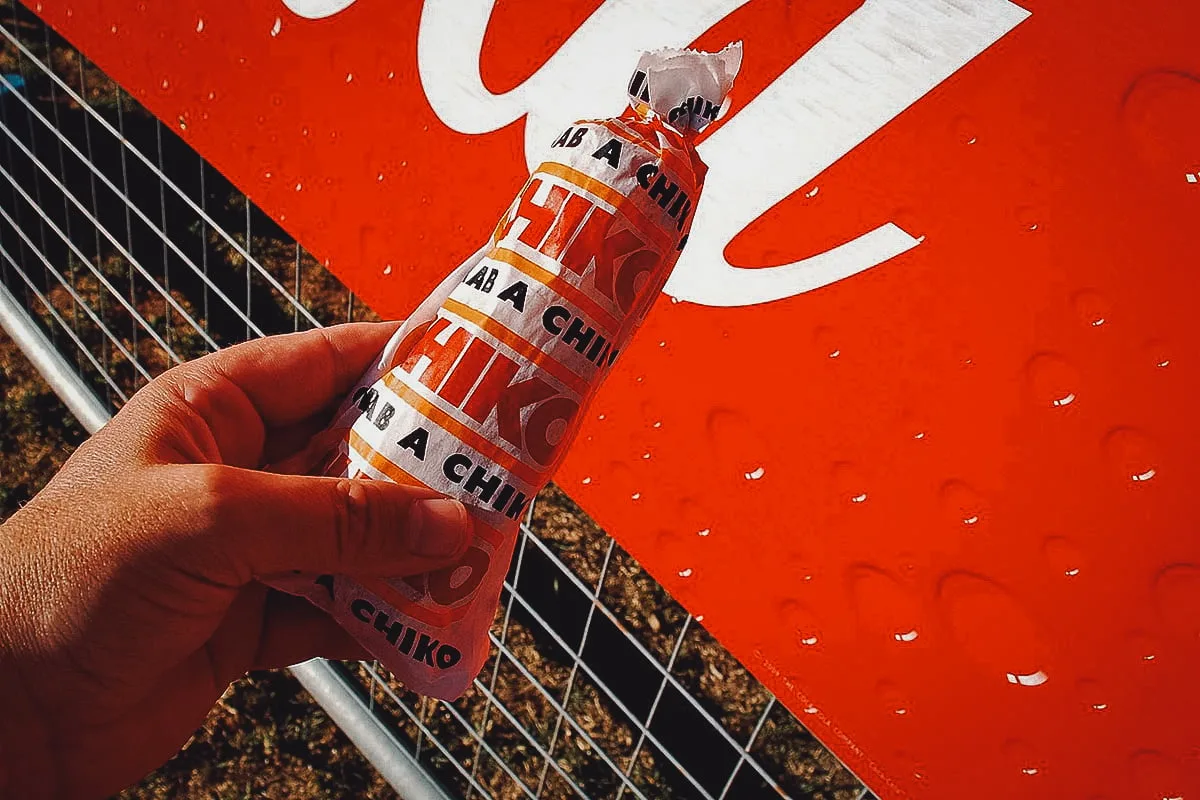
Mike Seyfang, CC BY 2.0, via Wikimedia Commons / Processed in Photoshop and Lightroom
5. Meat Pie
I’ve already described a few of the aforementioned dishes as “iconic” but no Australian dish deserves that label more than the Aussie meat pie. It’s widely considered to be the national dish of Australia.
Popular in Australia and New Zealand, meat pies are small hand-sized pies made with minced meat, gravy, and other ingredients like onions, garlic, peas, potato, and mushroom. Eaten as is or topped with tomato sauce or ketchup, it’s the preferred comfort food for many Australians and something they miss terribly when they leave the country.
I remember meat pies fondly. I was shocked at how expensive food in Sydney can be but the Aussie meat pie was one dish I could always rely on to fill me up and make me happy without breaking the bank.
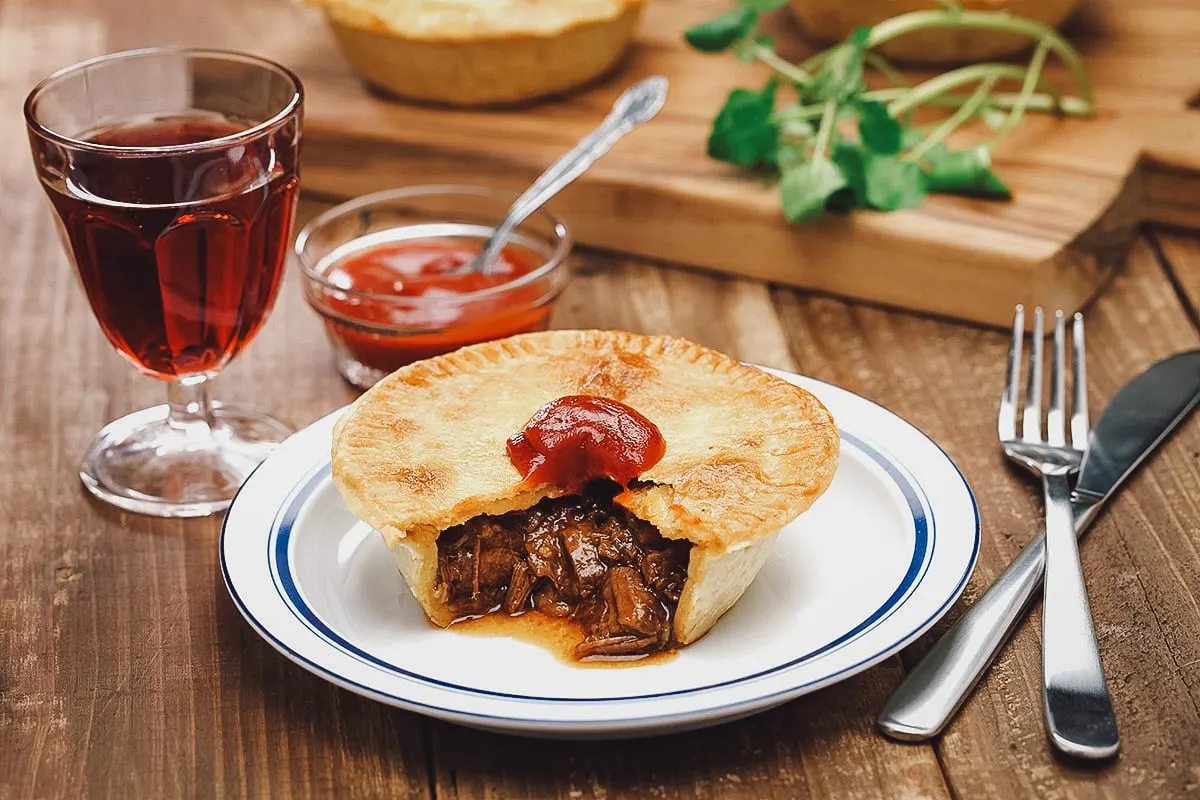
Photo by bonchan
6. Sausage Sizzle
A sausage sizzle is a simple Australian dish consisting of a grilled beef or pork sausage served in sliced white bread. Colloquially referred to as a “snag”, it can be topped with fried onions and condiments like mustard, tomato, or barbecue sauce.
A common snack served at community events like school fundraisers, the term “sausage sizzle” can refer to the actual dish, the grilling method, or the type of event it’s usually served at.
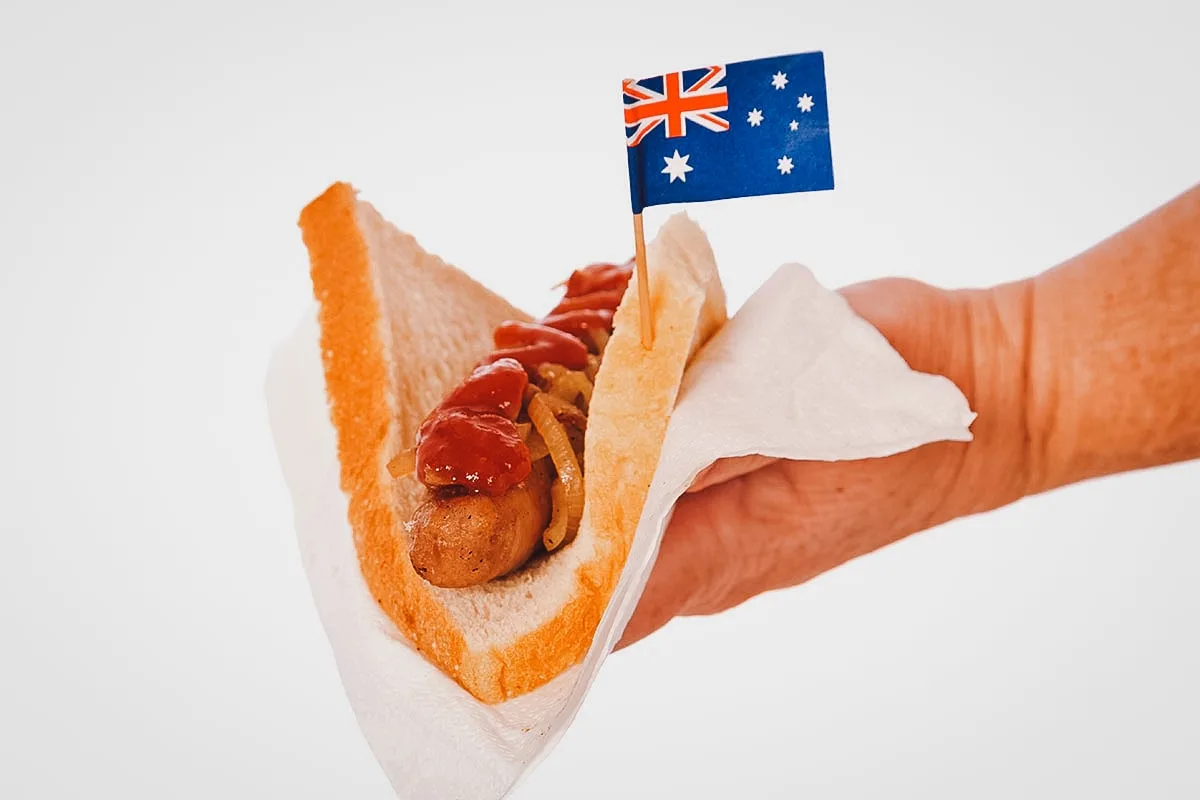
Photo by Tap10
7. Fish and Chips
If you’re fond of British cuisine, then the classic fish and chips is something you’re well familiar with. It refers to a simple but always satisfying pairing of battered and deep-fried fish fillets served with chips (french fries).
In the UK, fish and chips is commonly eaten with malt vinegar but in Australia, tartar or tomato sauce is preferred. Different types of fish like flathead, basa (Mekong Delta catfish), and barramundi (large-scaled river fish) are used while chicken salt – a garlicky seasoning originally intended for rotisserie chicken – is commonly used to flavor the chips.
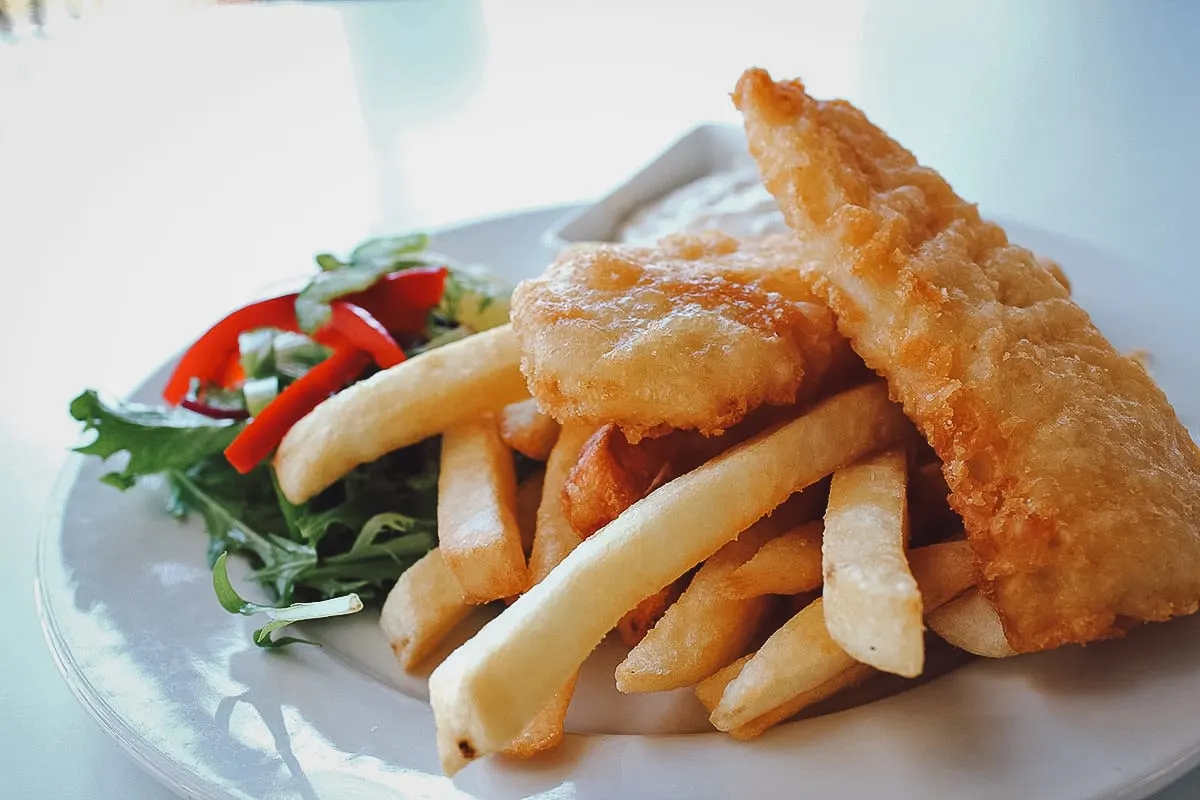
Photo by kmksk
8. Chicken Parmigiana
Chicken parmigiana (or chicken parmersan, chicken parma) may sound Italian but it’s actually an American dish that was created and popularized in the northeast United States by Italian immigrants in the 1950s.
Referred to colloquially as “parmy” or “parmi” in Australia, chicken parmigiana is believed to have made its way Down Under sometime in the 1980s. Today, it’s a pub staple that’s served in virtually every bistro across the country.
Like the American original, this classic Aussie chicken dish consists of breaded chicken schnitzel topped with tomato sauce and melted cheese. It’s typically served on top (as pictured below) or with a side of chips and salad.
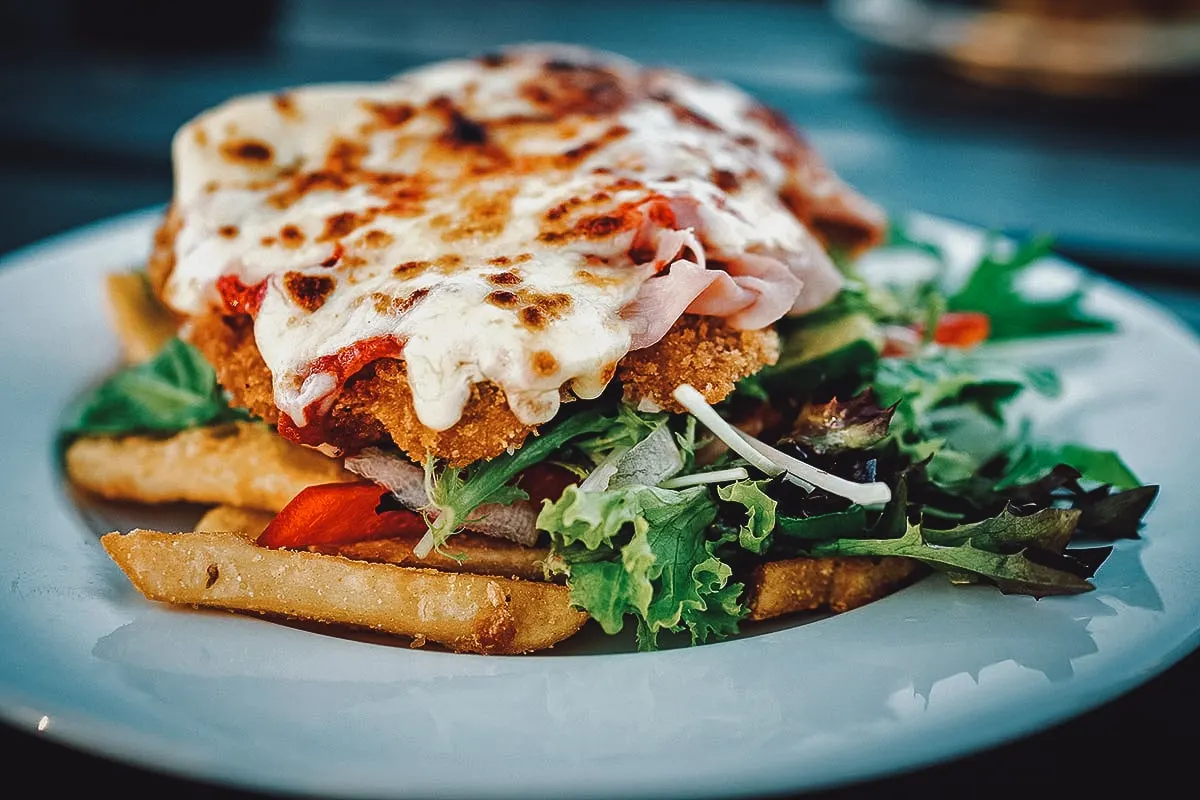
Photo by J Reynolds
9. Kangaroo Meat
As much as I loved the Aussie meat pie, proper Aussie bush tucker like kangaroo meat was the one thing I was most excited to try in Australia. With the kangaroo being a prolific and healthy species, I expected it to be a commonly consumed meat in Australia but that wasn’t the case.
As it turns out, the majority of Australians refuse to eat kangaroo meat. According to one local on Quora, only about a third of Australians have ever tried kangaroo, and only around 5% of the population eat it regularly. By regularly, I mean around 10-12 times a year. To many Australians, it’s more of a novelty meat, something that’s enjoyed on rare occasions like emu and crocodile meat.
I did some research and there are many reasons why the majority of Australians prefer not to eat kangaroo meat. One, kangaroos are wild-harvested, not farmed, so the meat can be a bit pricey. Two, kangaroo meat is more difficult to cook compared to beef or lamb. And three, many Australians just don’t like its strong gamey flavor.
Personally, I enjoyed kangaroo meat. It’s a gamier red meat that tastes similar to beef, but leaner. It’s said to be healthier as well – high in vitamin B12, iron, zinc, and omega-3 fatty acids. Plus, it’s been suggested that kangaroo farming will have a lesser impact on the environment than raising cattle.
Ecologists are encouraging Australians to eat more kangaroo meat because according to them, wild populations are becoming unsustainable. I thought it was delicious so I personally wouldn’t mind, but what do I know? I’m just a tourist.
The kangaroo is, after all, Australia’s national animal, so eating its meat remains rather stigmatized. In the words of the same Australian on Quora, “we grew up watching Skippy the Bush Kangaroo, so it is a bit like eating Lassie.”
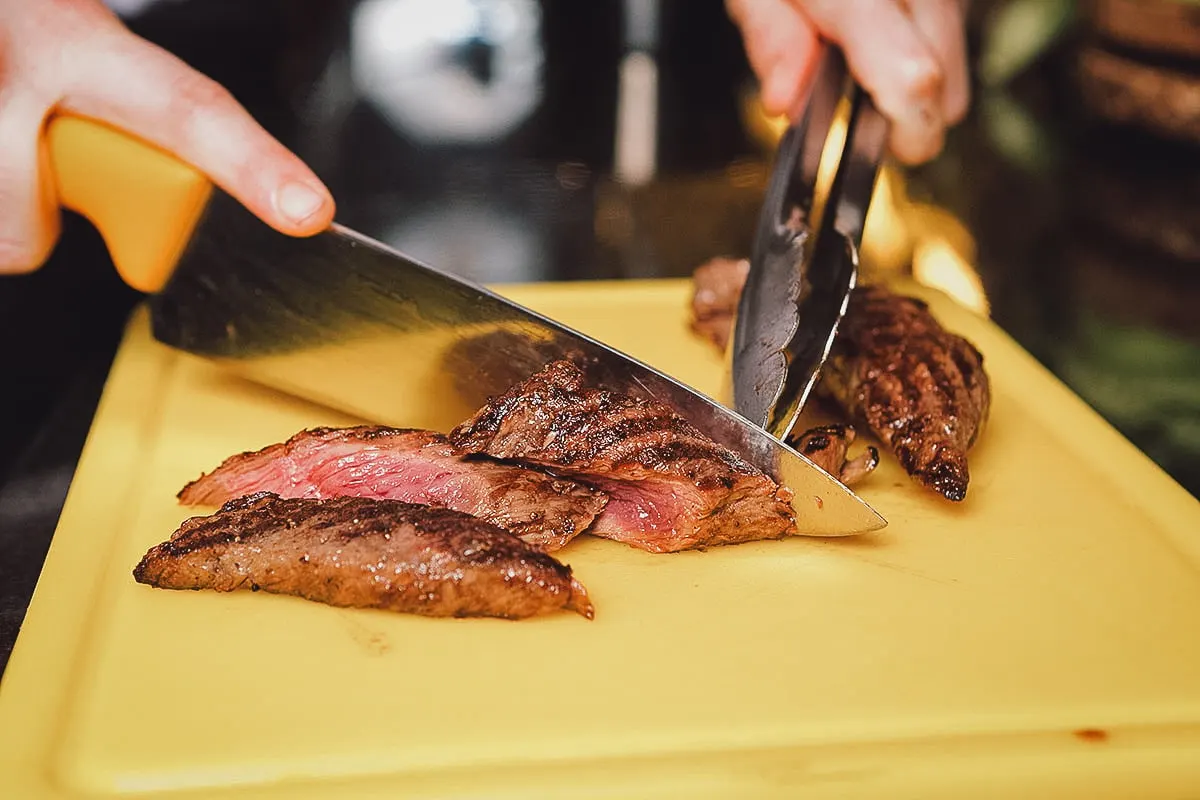
Photo by seeshooteatrepeat
10. Emu Meat
Another game meat you can try when you visit Australia is emu. Like Australia’s national animal, it’s high in protein and low in fat but it isn’t commonly eaten, even less so than kangaroo.
I’ve eaten ostrich but I haven’t gotten the chance to try emu in Australia. Typically cooked as steaks, it’s been described as a gamey red meat with a strong flavor. If it’s anything like ostrich, which I’m betting it is, then I’m sure it’s going to be delicious as well.
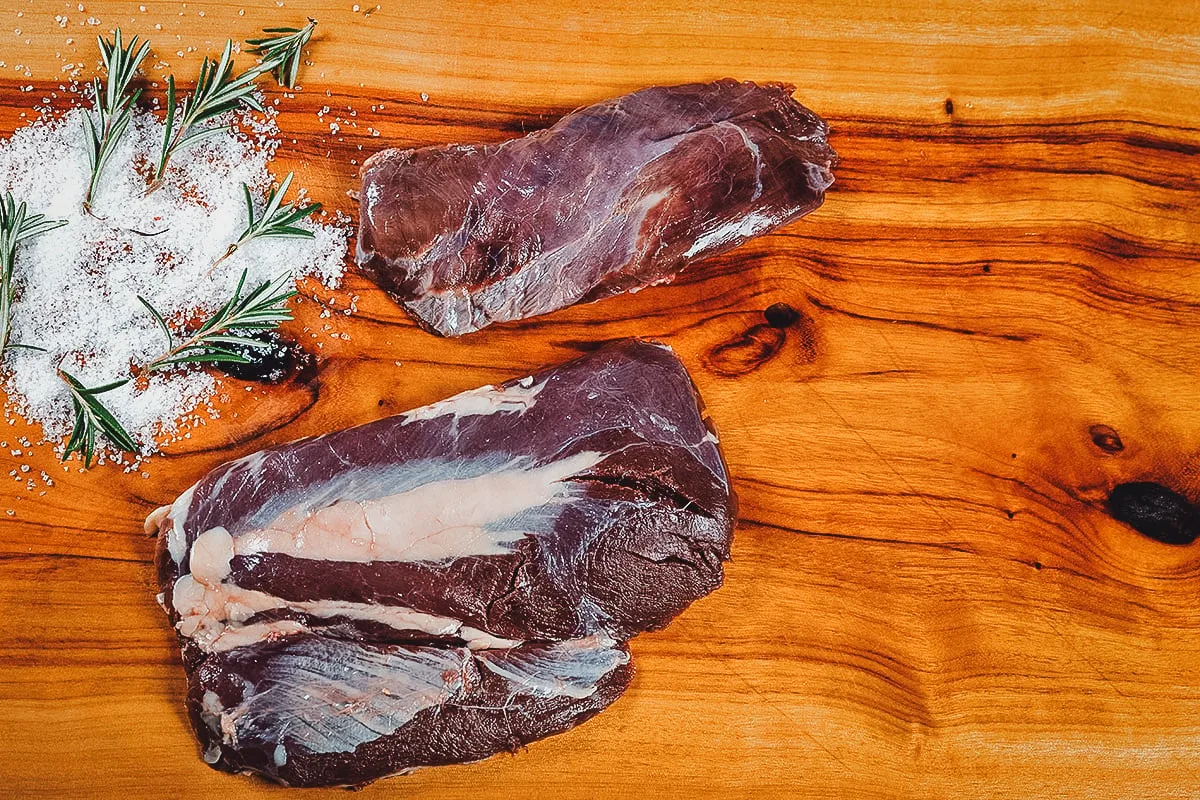
Photo by zstock
11. Barbecue
Who doesn’t love a good barbecue? Like Argentinian asado, South African braai, or Brazilian churrasco, the barbecuing tradition is an important social event in many cultures and it’s certainly no different in a country with lots of land and beautiful weather like Australia.
Aside from shrimp, you can pretty much throw anything on a barbie in Australia but some of the most preferred proteins include lamb, snags (sausages), prawn, beef, pork, and chicken. Snags are especially popular and come in many different varieties.

Photo by Ilia Torlin
12. Tim Tam
My wife’s cousin is a pilot who routinely flies to Australia and one of the things she always brings back are a few packs of Tim Tam.
Produced by Arnott’s, Australia’s largest biscuit and snack food manufacturer, Tim Tam refers to a chocolate-coated biscuit sandwich made with two malted biscuits and a cream filling. It’s made in different varieties like double-coated chocolate, dark chocolate mint, milk chocolate, caramel, and honeycomb.
Tim Tams are delicious on their own but I personally like them best when paired with a cup of coffee or hot chocolate. For fun, you can try doing the “Tim Tam Slam”. It’s the act of biting off both ends of a Tim Tam and then using it like a straw to drink your hot beverage.
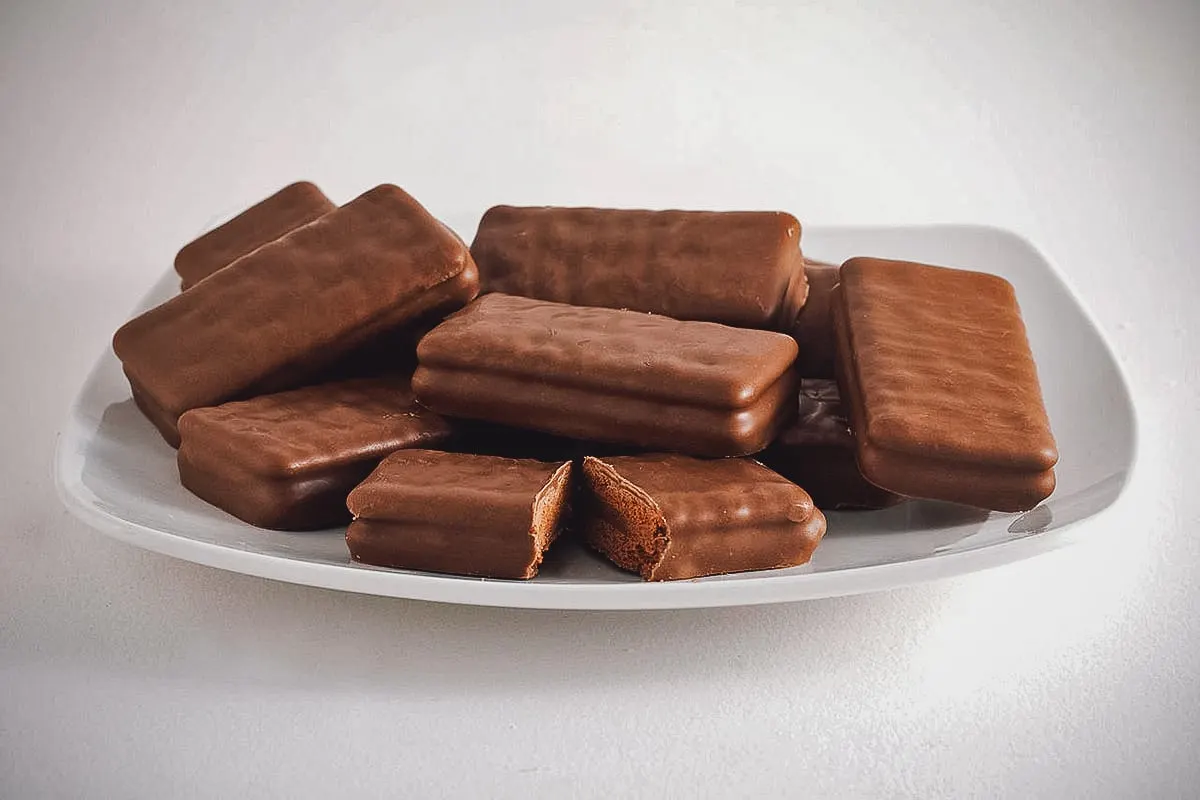
Bilby, CC BY-SA 3.0, via Wikimedia Commons / Processed in Photoshop and Lightroom
13. Anzac Biscuits
The Anzac biscuit is another snack or dish that’s popular in both Australia and New Zealand. It refers to a sweet biscuit made with flour, rolled oats, butter, sugar, golden syrup, and desiccated coconut.
Like a few dishes on this list, the origin of Anzac biscuits is disputed between Australia and New Zealand. ANZAC stands for Australia and New Zealand Army Corps, a collection of Australian and Kiwi soldiers that formed part of the allied expedition to capture the Gallipoli Peninsula during the First World War.
According to one story, Anzac biscuits came about when wives and women’s groups started sending them to soldiers overseas. It was their preferred biscuit for sending abroad because the ingredients used to make them kept well during naval transport.
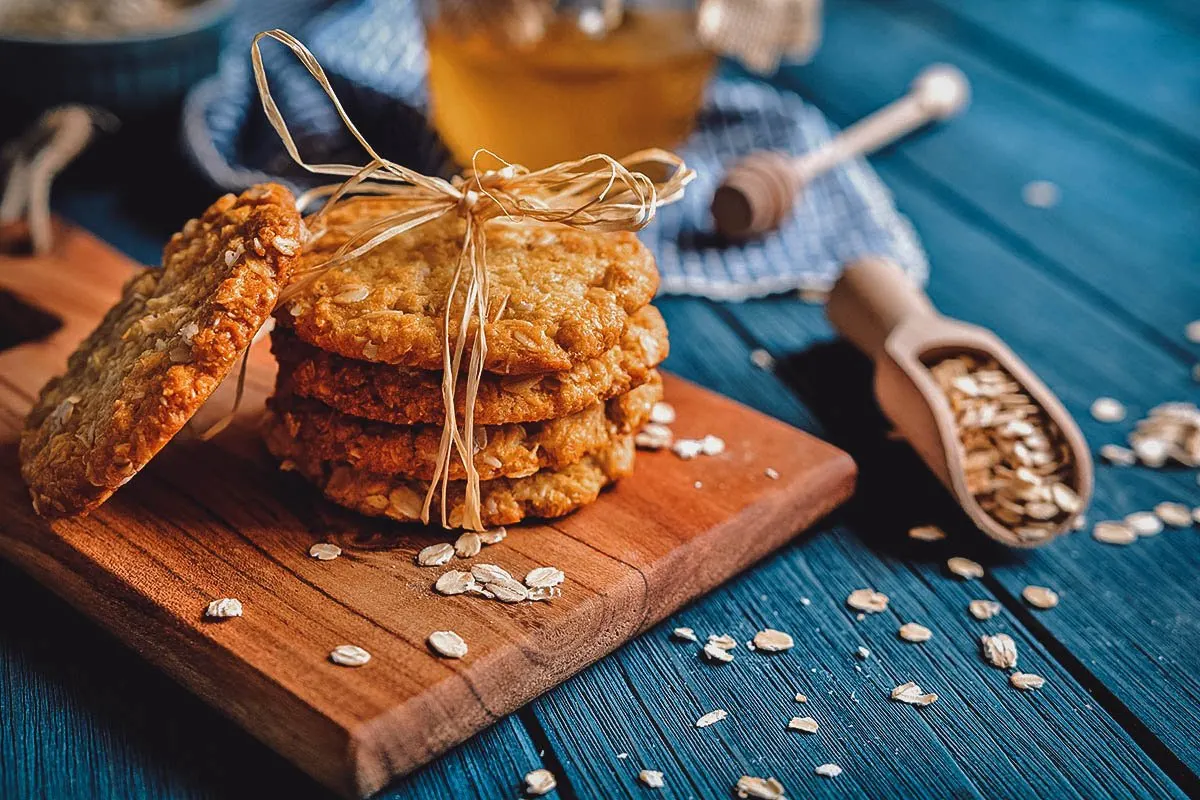
Photo by NoirChocolate
14. Lamington
The lamington is a type of cake that’s popular in both Australia and New Zealand. But unlike Anzac biscuits, its origin isn’t disputed. It’s definitively an Australian cake that was named after either Lord Lamington – the Governor of Queensland from 1896 to 1901 – or his wife, Lady Lamington.
As one story goes, the cake was created by Lord Lamington’s chef – Armand Galland. He was tasked at short notice to feed unexpected guests so he dipped slices of leftover French vanilla sponge cake in chocolate sauce before coating them in desiccated coconut. The impromptu dessert was a hit and the rest is history.
Today, lamingtons are made with cubes of butter or sponge cake that can contain a thin layer of cream or strawberry jam between the two halves. It’s a tasty dessert that’s also enjoyed in Croatia, where it’s known as čupavci.
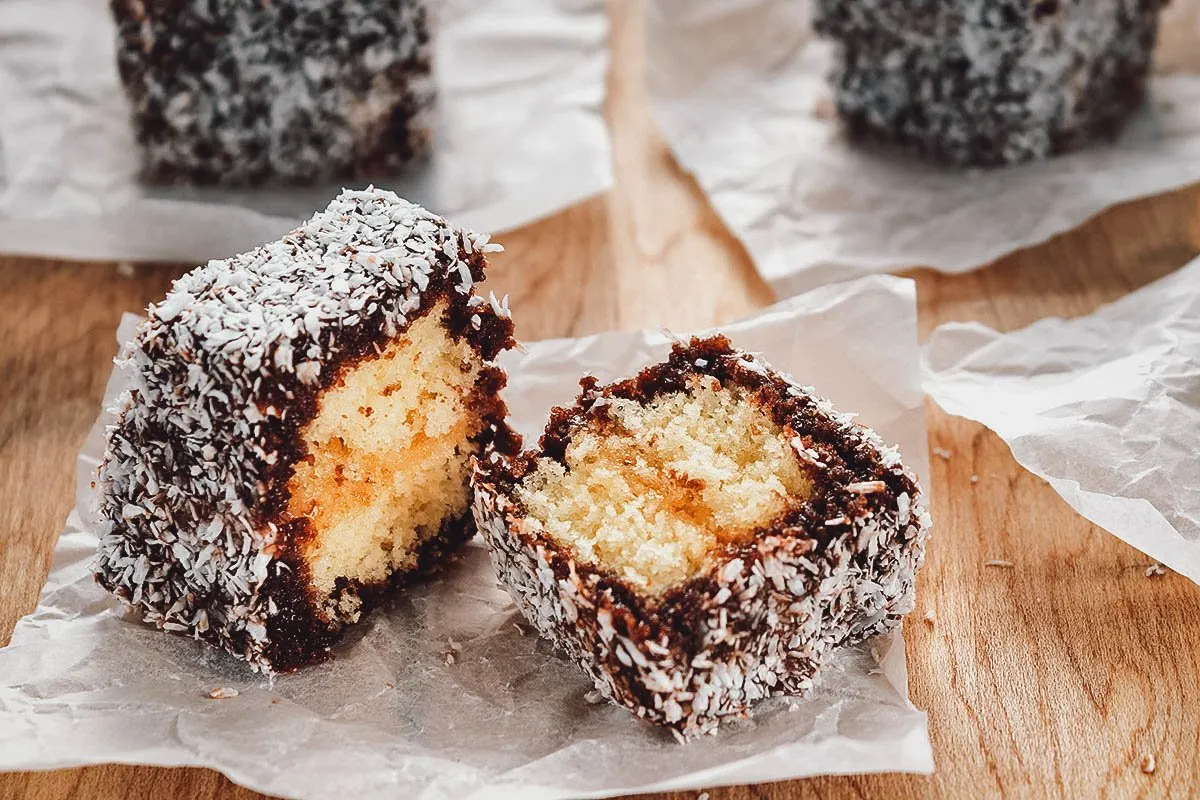
Photo by Dariozg
15. Pavlova
Last on this list of Australian food is another dish with disputed roots. Pavlova refers to a cake-like block of baked meringue that’s topped with fresh fruit and whipped cream.
My brother-in-law is Kiwi and he staunchly asserts that pavlova is originally from New Zealand. This dessert is so important to Kiwi culture and cuisine that it’s widely considered to be a New Zealand national dish.
The cake’s origins may be disputed but one thing is clear, it was named after Russian ballerina Anna Pavlova who toured Australia and New Zealand in the 1920s.
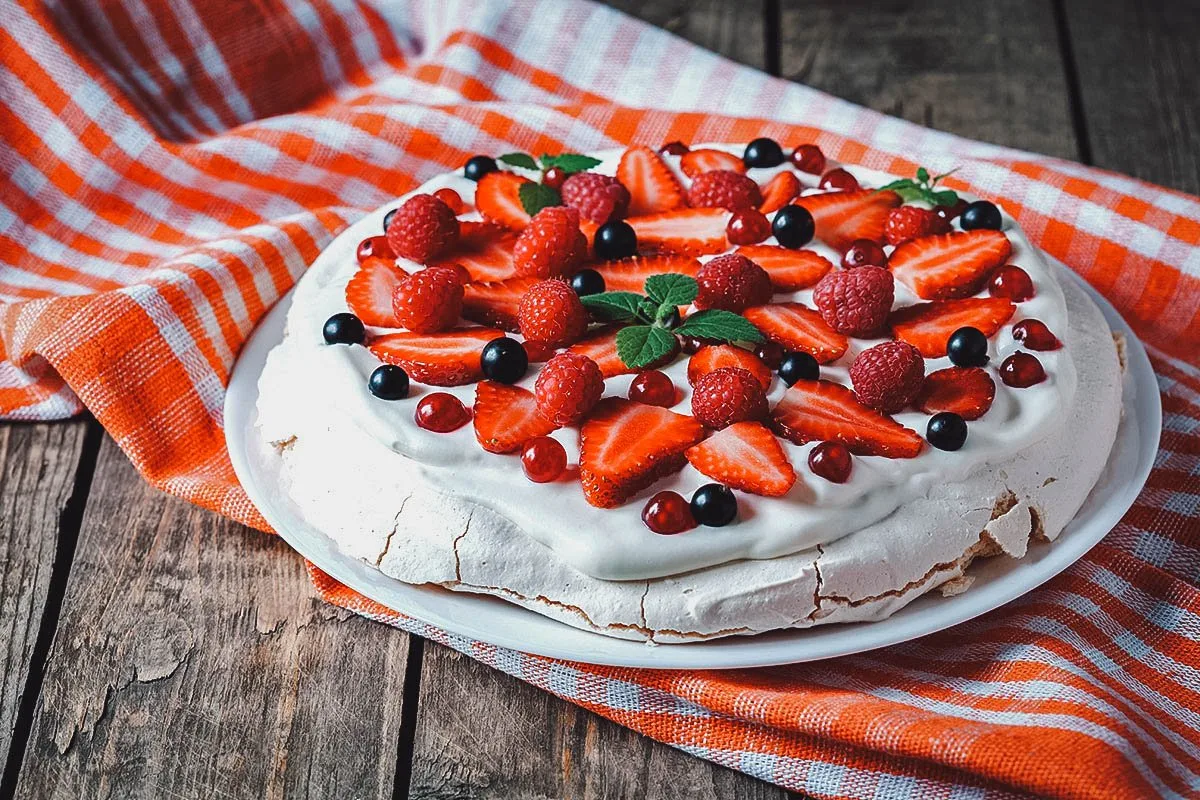
Photo by GreenArt_Photography
FINAL THOUGHTS ON AUSTRALIAN FOOD
Going back to the parallels between American and Australian cuisine, I wrote an article on my favorite countries for food and I included the USA as the last entry on the list. I got a lot of hate from people who strongly felt that the United States had no business being on any best cuisine list. They’re partly right, but that’s not why I included it.
The US may not have as strongly defined a cuisine but you can’t deny that the food in America is good. One Vietnamese food blogger living in California told me that in her opinion, the Vietnamese food in America is even better than the food in Vietnam, and a lot of that has to do with the quality of American ingredients.
I find Australia to be in a similar culinary predicament as the US. No one wants to give them their flowers because they don’t have as interesting or well-defined a cuisine, but you can’t deny that exciting things are being done in Australian kitchens.
Multicultural, fresh, and uninhibited by tradition, contemporary Australian cuisine is like that homeschooled kid who was never taught how NOT to do something. It thinks outside the box and that approach can often lead to the best results, much like in the US.
Disclosure
This Australian food guide contains affiliate links, meaning we’ll earn a small commission if you make a booking at no additional cost to you. As always, we only recommend products and services that we use ourselves and firmly believe in. We really appreciate your support as this helps us make more of these free food and travel guides. Thank you!
Cover photo by zstock. Stock images via Shutterstock.


Ashleigh
Tuesday 23rd of April 2024
Love this list! Remember when trying Vegemite you definitely don’t spread it on like the photo! The tiniest bit is good with lots of butter. It’s also great as a secret ingredient in gravy. Also pies are amazing, especially traveller pies (long thin ones) and even better, pies served with pea mash and gravy. So good. The other huge part of Australian cuisine is breakfast! The coffee culture and a sit down breakfast that can last hours with friends and healthy foods, I haven’t found that many other places in the world. In most subrurbs of Australia you will find a cafe that will do a bacon and egg roll, fresh squeezed juices, smashed avo, poached eggs with fritters and chilli jam, I miss it a lot!
JB & Renée
Friday 3rd of May 2024
Thanks so much for your input Ashleigh! Australian breakfast is definitely next level. Looking to experience more of it on our next trip back.